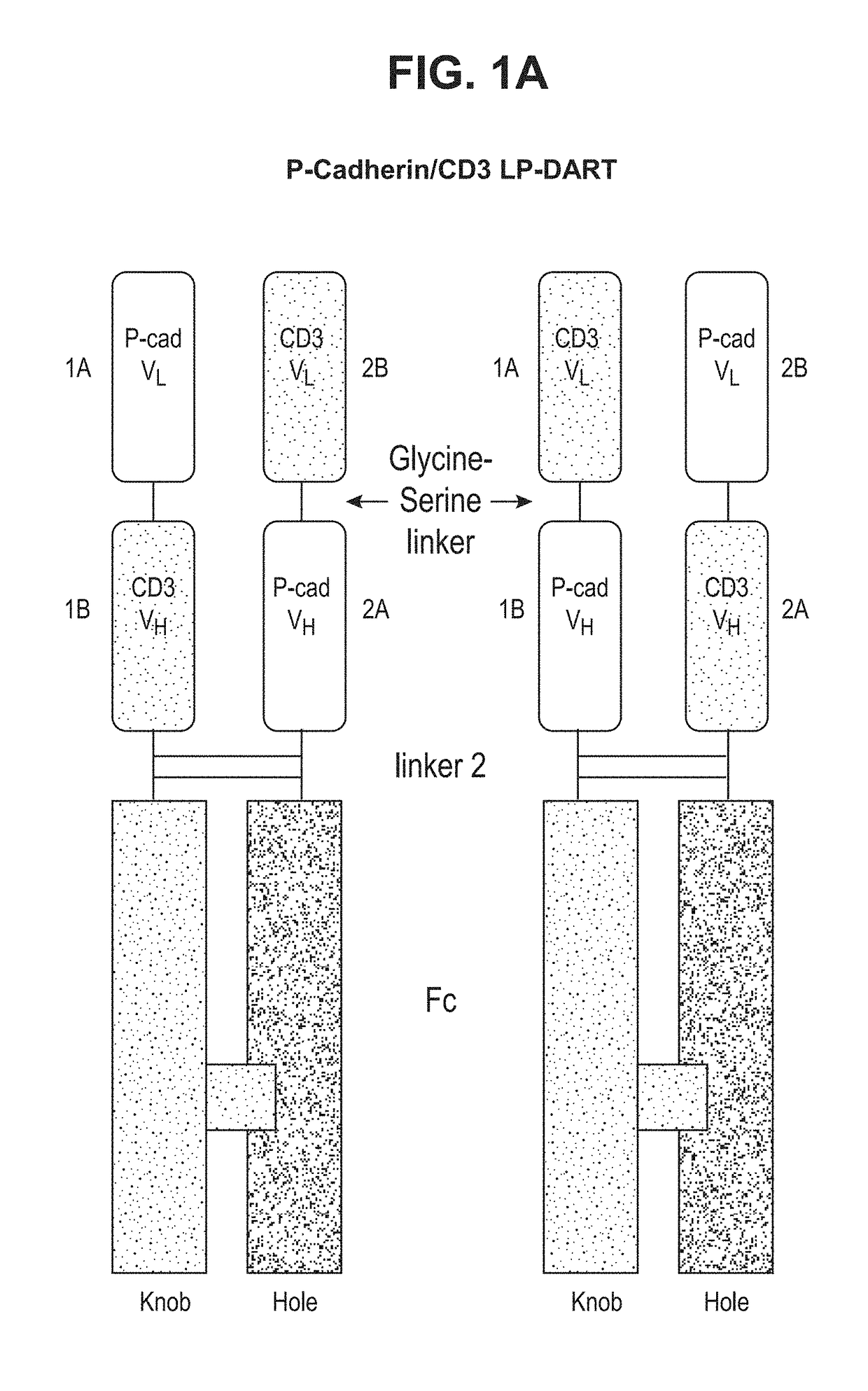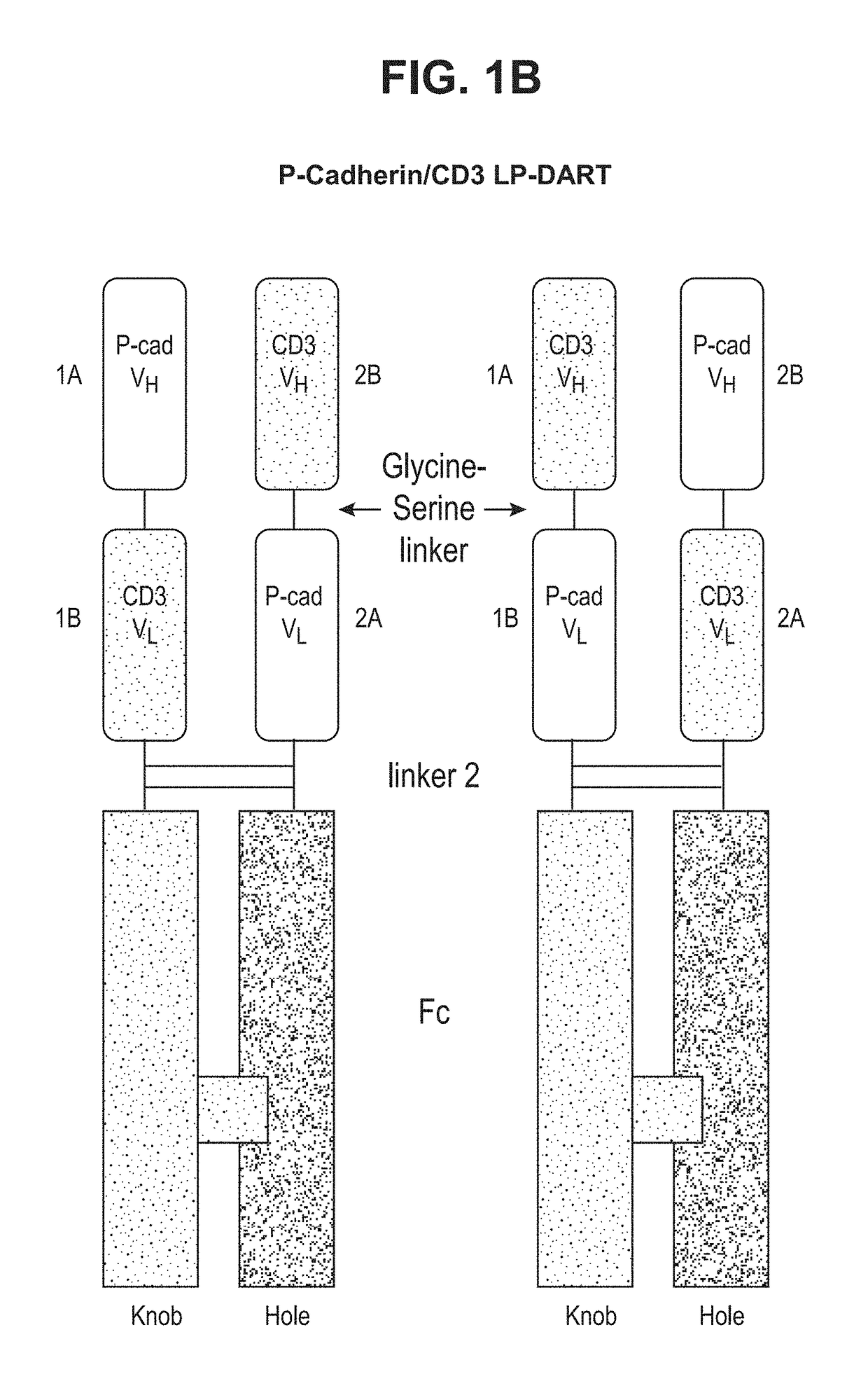Bispecific heterodimeric diabodies and uses thereof
a heterodimeric diabolic and bispecific technology, applied in the field of bispecific heterodimeric diabolics, can solve the problems of poor stability properties and limited efforts to produce such molecules, and achieve the effects of reducing solvent accessibility, increasing amino acid side chain volumes, and reducing linker length
- Summary
- Abstract
- Description
- Claims
- Application Information
AI Technical Summary
Benefits of technology
Problems solved by technology
Method used
Image
Examples
example 1
Generation of P-Cadherin Antibodies and Bispecific Heterodimeric Diabodies
[0232]Bispecific heterodimeric diabodies were constructed to assess the recombinant production, purification and binding characteristics of each. The affinity purified bispecific heterodimeric diabodies were produced by the recombinant expression systems described herein. ELISA and SPR analysis further revealed that the covalent bispecific heterodimeric diabodies exhibited affinity for both target antigens, P-cadherin and CD-3, and could bind both antigens simultaneously.
[0233]Single chain fragment variable (scFv) moieties that bind to the extracellular domain (ECD) of P-cadherin were identified with a phage display library composed of scFv derived from non-immunized human donors utilizing techniques known in the art. The binding of the scFvs expressed on the surface of phage was measured on P-cadherin protein constructs and P-cadherin-expressing cells by standard ELISA techniques.
B. Sequencing...
example 2
Construction of an Anti-P-Cadherin / Anti-Human CD3 LP-DART
[0258]Anti-P-cadherin / anti-human CD3 DART proteins were amplified by PCR such that each DART protein contained a restriction enzyme cloning site at each end for cloning into the mammalian expression vector, see Table 11 and FIGS. 33A and 33B.
[0259]
TABLE 11Anti-P-cadherin / anti-human CD3 DART proteins.DARTSEQUENCES35P-CAD 35VL(SEQ ID NO: 5)-Linker 1(SEQ ID NO: 68)-CD3-1 VH(SEQ ID NO: 45 or 46), andCD3-1-2VL(SEQ ID NO: 47)-Linker 1(SEQ ID NO: 69)-P-CAD 35VH(SEQ ID NO: 6)153P-CAD 153 VL (SEQ ID NO: 7)-Linker 1(SEQ ID NO: 68)-CD3 VH (SEQ ID NO: 45 or 46), andCD3 VL (SEQ ID NO: 47)-Linker 1(SEQ ID NO: 69)-P-CAD 153 VH (SEQ ID NO: 8)154P-CAD 154 VL (SEQ ID NO: 9)-Linker 1(SEQ ID NO: 68)-CD3 VH (SEQ ID NO: 45 or 46), andCD3 VL (SEQ ID NO: 47)-Linker 1(SEQ ID NO: 69)-P-CAD 153 VH (SEQ ID NO: 10)
[0260]Thereafter, nucleic acids encoding the DART protein sequences were fused to each nucleic acid encoding the modified Fc constructs e.g. th...
example 3
Binding Properties of P-Cadherin scFv-Fc and DART Proteins
[0262]The binding properties of P-cadherin scFv-Fc constructs (P-cadherin VH and VL fused to a human IgG Fc region) and DART proteins to P-cadherin protein constructs and to P-cadherin expressing cells were analyzed using standard ELISA techniques. The data in Table 12 demonstrates that the phage derived P-cadherin scFv-Fc constructs had strong binding to recombinant human P-cadherin and no detectable binding to murine P-cadherin.
[0263]
TABLE 12Binding properties of P-cadherin scFv-Fcto P-cadherin protein constructs.huP-cad-ECDP-CAD ClonehuP-cad-ECDbiotinylatedmuP-cad-ECD#EC50 (nM)EC50(nM)EC50 (nM)33 scFv-Fc3.4640.1012NB34 scFv-Fc11.160.1943NB35 scFv-Fc2.50.01762NBPF037320101.9360.01882.333Neg ControlNBNBNBNB = no detectable binding
[0264]The binding properties of P-cadherin scFv-Fc to various P-cadherin expressing cell types in cell-based ELISA is shown in Table 13. The phage derived P-cadherin scFv-Fc constructs demonstrated ...
PUM
| Property | Measurement | Unit |
|---|---|---|
| temperatures | aaaaa | aaaaa |
| density | aaaaa | aaaaa |
| density | aaaaa | aaaaa |
Abstract
Description
Claims
Application Information
 Login to View More
Login to View More - R&D
- Intellectual Property
- Life Sciences
- Materials
- Tech Scout
- Unparalleled Data Quality
- Higher Quality Content
- 60% Fewer Hallucinations
Browse by: Latest US Patents, China's latest patents, Technical Efficacy Thesaurus, Application Domain, Technology Topic, Popular Technical Reports.
© 2025 PatSnap. All rights reserved.Legal|Privacy policy|Modern Slavery Act Transparency Statement|Sitemap|About US| Contact US: help@patsnap.com



